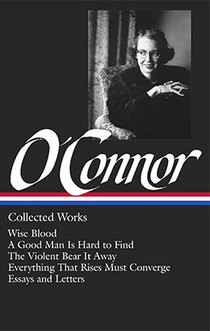From Flannery O’Connor: Collected Works
Interesting links
Flannery O'Connor: the writer versus the believer (Reader's Almanac)
Interview with Brad Gooch, author of Flannery (PDF, The Library of America)
Andalusia: The Home of Flannery O'Connor (Andalusia Foundation)
Buy the book
 Flannery O'Connor: Collected Works
Flannery O'Connor: Collected Works
Wise Blood | A Good Man Is Hard to Find | The Violent Bear It Away | Everything That Rises Must Converge | essays and letters
Flannery O'Connor: the writer versus the believer (Reader's Almanac)
Interview with Brad Gooch, author of Flannery (PDF, The Library of America)
Andalusia: The Home of Flannery O'Connor (Andalusia Foundation)
Buy the book
 Flannery O'Connor: Collected Works
Flannery O'Connor: Collected WorksWise Blood | A Good Man Is Hard to Find | The Violent Bear It Away | Everything That Rises Must Converge | essays and letters
O’Connor enjoyed enviable success soon after finishing her studies at the Iowa Writers’ Workshop in 1947. On the basis of her student work and a draft of her novel-in-progress, she received the Rinehart-Iowa Award of $750 and an option for her first book. “The Train,” the last of six stories in her MFA thesis (titled The Geranium), was accepted by the respected quarterly Sewanee Review, which published it as simply “Train” in the April 1948 issue.
She was invited to stay at Yaddo, the renowned artists’ colony in Saratoga Springs, New York, where she befriended the poet Robert Lowell, who regarded her as a favorite protégé. In his recent biography Brad Gooch describes the transformation of her story into the novel’s first chapter:
She was making progress, thinning out and pacing the opening. “Well I can’t sustain that,” she told Sally [Fitzgerald] when her friend praised “The Train.” “I have to tone it down.” Haze Motes, in his “glaring blue” suit and “hat that an elderly country preacher would wear,” was coming into focus as a slightly demented saint in the making, a shift in direction that Sally thought perhaps “due to criticism by [Robert] Lowell.”Another recent arrival at Yaddo was Alfred Kazin, who immediately took note of O’Connor’s work and alerted Robert Giroux, a junior editor at Harcourt Brace. When Lowell finally introduced her to Giroux in New York, O’Connor was faced with a dilemma rare for a first-time author: she had two publishers vying for her unfinished book. Angered by Rinehart’s criticisms (which she regarded as “addressed to a slightly dim-witted Camp Fire Girl”), she refused to agree to their extensive editorial changes. Rinehart ultimately released O’Connor from the option on her book, allowing Harcourt to publish Wise Blood in 1952.
In “The Train,” as in the novel, Haze is traveling to Taulkinham, but the story’s final destination is a night in the train itself. Instead of a “slightly demented saint in the making,” Haze is a nineteen-year-old youth, alone and nervous and clumsy and haunted by the death of his mother. His thoughts are disturbed by the resemblance of a black porter to someone back home, by a chatty woman sitting near him on the train, and by the prospect of spending the night in the coffin-like sleeper berth.
* * *
Thinking about the porter, he had almost forgotten the berth. He had an upper one. . . . If you don't see the full story below, click here (PDF) or click here (Google Docs) to read it—free!
This selection is used by permission. Teachers: Note that this story contains several uses of the n-word. To photocopy and distribute this selection for classroom use, please contact the Copyright Clearance Center.
